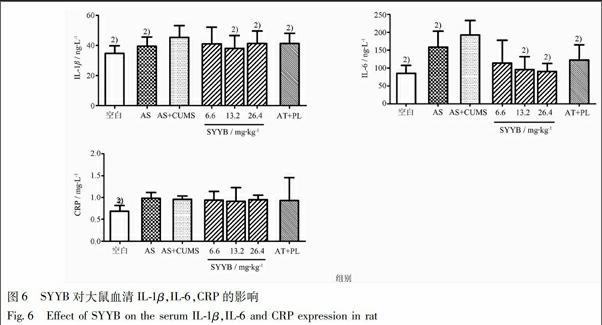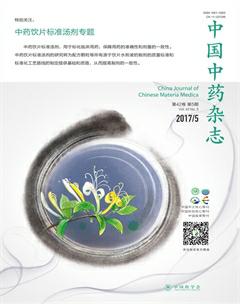舒郁抑斑方对慢性心理应激促发动脉粥样硬化大鼠的保护作用
郑晓俊+胡志强+栾淑伟+李冉+李赟+李建良+李玉洁+朱晓新



[摘要]舒郁抑斑方(SYYB)對伴有慢性心理应激的冠心病患者有较好的治疗作用。为观察SYYB对慢性心理应激促发大鼠动脉粥样硬化(athero-sclerosis,As)早期病变形成及其炎症反应的影响,采用高脂饵食+维生素D3(VD3)腹腔注射建立大鼠As早期病变模型(As),在此基础上采用不可预知慢性应激刺激法(As+CUMS),观察慢性心理应激是否加重大鼠病变及SYYB(6.6,13.2,26.4 mg·kg-1)的干预作用。采用悬尾实验和新奇实验法观察大鼠行为学改变,检测血清应激激素促肾上腺素(adrenocortico-tropic hormone,ACTH)、皮质醇(cortisol,Cor)、去甲肾上腺素(noradrenaline,NE)的含量,称量胸腺、肾上腺的质量,综合评价SYYB对模型大鼠心理应激的影响。取主动脉弓HE染色观察血管组织病理改变,测定血清甘油三酯(triglycerides,TG)、总胆固醇(total cholesterol,TC)、高密度脂蛋白(HDL-C),评价SYYB对大鼠As病变的影响。检测血清高敏C反应蛋白(high-sensitivity C-reactive protein,hsCRP)、白细胞介素-1β(interleukin-1β,IL-1β)、白细胞介素-6(interleukin-6,IL-6),评价SYYB对As大鼠炎症反应的影响。实验结果显示,与空白组相比,As组TC,TG含量增高,HDL-C明显降低,HE染色可见主动脉壁增厚。As+CUMS组TC,TG含量显著增高,HDL-C明显降低,HE染色可见主动脉弓内膜增厚,泡沫细胞形成,行为学评价及血清应激激素检测结果显示动物存在慢性应激反应,该实验As+CUMS模型复制成功。SYYB可降低血清中TC,TG含量,减轻主动脉泡沫细胞、钙化灶及炎性细胞浸润,对血清中ACTH和Cor,NE有明显的降低作用,同时有效降低了血清中动脉粥样硬化相关的炎性标志物hs-CRP,IL-1和IL-6。提示SYYB对心理应激促发As大鼠的保护作用,其作用与改善神经-内分泌网络平衡及调节相关炎症反应有关。
[关键词] 舒郁抑斑方; 动脉粥样硬化; 心理应激; 炎症
[Abstract] Shuyu Yiban decoction(SYYB) has significant effect in treating the patients with coronary heart disease combined with chronic psychological stress. In this study, in order to observe the effects of SYYB on early formation of atherosclerosis(As) and inflammation response induced by chronic psychological stress, high-fat diet+intraperitoneal injections of Vitamin D3 were given to establish As early lesion models, and based on these models, chronic unpredictable mild stress(CUMS) was used to observe whether the chronic psychological stress could increase coronary atherosclerotic lesions investigate the intervention effect of SYYB(6.6, 13.2, 26.4 mg·kg-1). The tail suspension test and novelty-feeding test were adopted to detectadrenocortico-tropic hormone(ACTH), cortisol(Cor) andnoradrenaline(NE) in serum and weigh thymus and adrenal gland, in order to assess the effects of SYYB on CUMS model rats. The pathological changes of vascular tissues in aortic arch were observed by using hematoxylin and eosin(HE) staining, and then the levels of triglycerides(TG), total cholesterol(TC) and high density lipoprotein(HDL-C) in serum were determined to assess effects of SYYB on As lesions. The effects of SYYB on the inflammatory response in As rats were assessed by detecting high-sensitivity C-reactive protein(hsCRP), interleukin-1β(IL-1β) and interleukin-6(IL-6) in serum. The results showed that as compared with the blank control group, TC and TG levels in As group were increased while HDL-C was markedly decreased; furthermore, the aortic wall was thickened in HE staining.Meanwhile, foam cells were formed, and the behavioral assessment and serum stress hormone test showed that there was a chronic stress response, indicating successful establishment of As+CUMS models in this study. The experiment demonstrated that SYYB could lower the levels of serum TC and TG, reduce foam cells, calcification and inflammatory cells infiltration. Moreover, SYYB could obviously lower levels of ACTH, Cor and NE and the As related inflammatory indicatorhs-CRP, IL-1β and IL-6 in serum.These results indicated that SYYB had protective effect on chronic psychological stress induced in As rats, and the mechanism was associated with balancing the neuroendocrine-immune network system and regulating inflammation response.
[Key words] Shuyu Yiban decoction; atherosclerosis; psychological stress; inflammation
随着我国社会经济的变革和人们生活方式的变化,心血管病,特别是动脉粥样硬化(atherosclerosis,As)性心血管病发病率和死亡率持续增长,已经成为我国重要的公共卫生问题。近年来的大规模流行病学研究不断证实,心理因素可影响As斑块形成,有报道约40%的冠心病与心理应激密切相关,特别是高脂人群和久坐人群[1],可以直接诱发心绞痛、心肌梗死急性发作及使预后恶化。有报道,长期慢性心理应激人群自主神经功能紊乱,颈动脉内膜中膜厚度明显增高,且在遭受急性应激后心率、窦性心律及射血前期恢复缓慢,表明慢性应激促进As形成,增加心血管疾病的风险[2]。心理应激已发展成为促进As的发展、触发临床心血管事件的关键危险因素之一[1,3-4]。通过调整生活方式、改善心理状态、适当服用药物等方法减少As的形成发展[5]已成为心血管病预防领域新的趋势和共识。
中医学认为,心理应激当属“郁证”、“肝燥”、“百合病”、“瞀闷”等范畴,为情志不舒,气机不畅,始发于肝,出现情绪低落或情绪不稳的证候群。治疗多以疏肝解郁、安神开窍、调和肝脾、豁痰理气、补益心脾、活血化瘀为法。舒郁抑斑方(SYYB)来源于国家级名老中医李济春先生临床经验方,以疏肝、活血、解毒为法,主要由柴胡、川芎、丹参、穿心莲等药味组成,可明显减轻As心脑血管疾病患者临床症状,同时改善患者心理状态,其作用机制亟需深入研究。该文在建立慢性心理应激促发的As模型基础上,观察SYYB对As病变形成、进展过程及其炎症反应的影响,并从神经-内分泌紊乱角度探讨SYYB作用机制。
1 材料
1.1 动物
雄性Wistar大鼠,体重180~200 g,由北京维通利华实验动物有限公司提供,动物许可证号SCXK(京)2012-0001;每笼5只,自由摄食、饮水,饲养室温度为20~25 ℃,相对湿度40%~70%。
1.2 药品与试剂
维生素D3注射液(上海通用药业股份有限公司,批号 20130910)。舒郁抑斑方(SYYB):采用水提醇沉法制备,浓缩至生药4 g·mL-1,高压灭菌保存,由中国中医科学院中药研究所提供,批号20140930;阿托伐他丁钙片(美国辉瑞公司,批号029012K);盐酸帕罗西汀片(中美天津史克有限公司,批号H10950043);大鼠高脂饲料(SPF级,北京科澳协力饲料有限公司,批号20141024)。
2 方法
2.1 造模
用高脂饲料(3%胆固醇,10%猪油,0.2%丙基硫氧嘧啶、0.5%胆酸钠,5%白糖)饲养大鼠,适应性喂养1周后,单次以30 mg·kg-1的剂量腹腔注射维生素D3(vitamin D3,VD3)。在高脂造模4周后,采用不可预知的慢性应激模型[6-7](chronic unpredictable mild stress,CUMS)通过心理应激刺激加重As损伤。CUMS主要的方法是施以28 d长期应激刺激,刺激类型包括:夹尾(2 min)、禁水(24 h)、潮湿垫料(将200 mL水加入有锯末的笼底,24 h)、昼夜颠倒(24 h)、水平震荡(15 min),每天随机给予1种刺激,共进行28 d,制备慢性心理应激下的动脉粥样硬化早期病变模型。
2.2 动物分组及处理情况
将高脂+VD3建立的As模型大鼠随机分成As模型组(As)、As模型+应激刺激组(As+CUMS)、SYYB分为低剂量组(6.6 mg·kg-1)、中剂量组(13.2 mg·kg-1)、高剂量组(26.4 mg·kg-1)、阳性药组(AT+PL,各 2 mg·kg-1),每组10只,各组喂食高脂饲料满8周。另取10只Wistar大鼠作为空白组(Control),并给予8周普通饲料。喂食高脂饲料4周后除空白组和As模型组外,其他各组大鼠给予不间断28 d不可预知的慢性应激。造模结束后开始灌胃给药,除空白组大鼠喂食8周普通饲料外,其他组大鼠持续喂食8周高脂饲料。
2.3 检测指标
8周后,采用悬尾实验,记录大鼠倒置体位不动时间,每只大鼠观察5 min[8-9]。采用新奇实验方法,将大鼠在禁食36 h后,放入一个新的未接触过的新环境中,测试并记录动物自放入笼中至首次摄食的时间[10-11]。取血,放免方法检测应激激素促肾上腺素(ACTH)、皮质醇(Cor)的含量,用ELISA方法检测去甲肾上腺素(NE)含量,取出胸腺和双侧肾上腺,称量质量,计算胸腺指数、肾上腺指数,胸腺指数(肾上腺指数)=胸腺质量(肾上腺质量)/大鼠体重,综合反映动物的慢性心理应激的程度。
取血檢测总胆固醇(TC),甘油三酯(TG),高密度脂蛋白(HDL-C)含量,采用全自动生化检测仪进行检测,并计算动脉硬化指数(AI)。ELISA法检测高敏c反应蛋白(hs-CRP)及白介素-1(IL-1β),白介素-6(IL-6)。主动脉弓取材,苏木素-伊红(HE)染色处理后,观察其病理变化。
2.4 统计方法
数据以±s表示。运用SPSS 16.0软件,采用方差分析(ANOVA)进行统计处理,2组间比较采用LSD检验,以P<0.05作为差异存在统计学意义的界限。
3 结果
3.1 SYYB对As+CUMS大鼠应激反应的影响
3.1.1 对As+CUMS大鼠行为学的影响 与As组相比,As+CUMS组大鼠摄食时间明显延长(P<0.01),悬尾静止时间有延长趋势。与As+CUMS组相比,SYYB低、中、高剂量组大鼠摄食时间均显著缩短(P<0.05),见图1。
3.1.2 SYYB对As+CUMS大鼠血清应激激素ACTH,Cor,NE含量的影响 与As组相比,血清中ACTH,Cor的含量显著升高(P<0.05),NE的含量无明显变化。与As+CUMS组相比,SYYB低、中、高剂量组血清中ACTH,Cor,NE的含量有不同程度的改善作用,其中高剂量组作用显著(P<0.05或P<0.01),见图2。
3.1.3 SYYB对As+CUMS大鼠脏器指数影响 与As组相比,As+CUMS组大鼠的肾上腺指数显著升高(P<0.05),胸腺指数无明显变化。与As+CUMS组相比,SYYB低、中、高剂量组大鼠的肾上腺指数显著降低(P<0.05),见图3。
3.2 SYYB对As+CUMS大鼠As病变的影响
3.2.1 SYYB对As+CUMS大鼠血脂变化的影响 与As组相比,As+CUMS组大鼠血清中TC,TG的含量明显升高(P<0.01),HDL-C的含量明显降低(P<0.05)。与As+CUMS组相比,SYYB低、中、高剂量组及阳性药组大鼠血清中TC,TG的含量明显降低(P<0.05),HDL-C的含量有升高趋势。与As+CUMS组相比,SYYB低、中、高剂量组及阳性药组大鼠的动脉硬化指数(AI)明显降低(P<0.05),见图4。表明SYYB可改善脂质代谢,对As形成有一定的作用。
3.2.2 SYYB对As+CUMS大鼠血管病理形态学改变的影响 空白组动脉内膜表面光滑完整,无炎性细胞浸润及钙化灶。As模型组主动脉增厚,可见脂纹。As+CUMS组血管内膜增厚,粗糙,管壁钙化明显,可见脂纹、水肿及炎性细胞浸润。SYYB低剂量与As+CUMS组无明显变化,但中剂量组、高剂量组的内膜完整,斑块形成程度与As+CUMS组比有明显减轻,炎性细胞较少,见图5。
3.2.3 SYYB对As+CUMS大鼠血清炎症因子的影响 与As组相比,As+CUMS组大鼠的血清中hsCRP,IL-1β和IL-6含量明显升高(均P<0.01);与As+CUMS组相比,SYYB低、中、高剂量组大鼠的血清中IL-1β和IL-6的含量显著下降(P<0.05),hsCRP含量有降低趋势,差别无统计学意义,见图6。表明SYYB可以有效降低血清中As相关的炎性标志物,从而影响斑块稳定性。
4 讨论
现代医学已经由过去单纯生物医学模式向生物-心理-社会医学模式转变,世界卫生组织(WHO)对“健康”的认识不仅仅是停留在没有疾病,而是身体-心理-社会适应的一种良好的状态[12-13]。与之相应,我国明代的中医古籍《景岳全书》中既已明确提出了“因病而郁”和“因郁而病”理论。近年来随着生活水平的不断提高以及社会竞争的日益激烈,心理因素促发的动脉粥样硬化性疾病严重威胁人类的健康,有心理应激倾向人群罹患心血管疾病的危险性增加2~4倍[14],心理应激成为冠心病发生的一个独立的危险因素[15-16]。
作者的前期研究显示中药SYYB既可改善冠心病症状又可效缓解患者紧张情绪。本课题在动脉粥样硬化经典模型的基础上给予不可预知的慢性应激(CUMS),从干预心理应激角度探索SYYB干预As的作用机制。
CUMS模型的建立经历了多种慢性低强度刺激,更能表现心理应激的病理生理状态。CUMS主要的方法是接收28 d长期应激刺激,刺激包括夹尾、禁水、潮湿垫料、昼夜颠倒、水平震荡,每天随机给予1种刺激,让动物没有任何心里准备。CUMS模型可使抑郁状态保持较长时间,具有高度有效性,更加接近现实。对于CUMS模型评价该文采用悬尾实验和新奇实验及血清应激激素变化。实验造模过程中,动物在接受28 d长期应激刺激同时,施以高脂饵食及VD3注射,多因素诱发As斑块形成。实验结果显示,模型组TC,TG含量显著增高,HDL-C明显降低,HE染色可见主动脉弓内膜明显增厚,泡沫细胞聚集,炎症细胞的浸润,并可见明显的钙化灶,同时悬尾实验和新奇实验结果及血清应激激素水平表明,模型大鼠存在明显慢性心理应激反应,本实验模型复制成功。
心理应激诱导、加重的As机制十分复杂,其发病机制可能与机体的神经内分泌-免疫系统网络系统调节紊乱有关[17-20]。心理应激使神经-内分泌系统反应较为敏感,蓝斑-去甲肾上腺素能神经元/交感-肾上腺髓质轴(locus ceruleus-nore pineph-rine/sympathetic-adrenal medulla axis,LC/NE)和下丘脑-垂体-肾上腺皮质轴(hypothalamus-pituitary-adrenal cortex system,HPA) 功能持续亢进,从而增加了促肾上腺素、皮质醇、去甲肾上腺素的合成与分泌,且神经或淋巴细胞衍生的细胞因子显著增加,在應激损伤中发挥重要作用,导致严重神经精神症状,并可以反馈机制调节HPA轴以及靶器官。同时,交感神经节后纤维释放的神经递质能够在软组织中弥散,与轴突附近的巨噬细胞等细胞肾上腺素能受体相互作用,也可介导交感神经调节的细胞因子水平和炎症反应[21-23]。
SYYB对模型组血清中促肾上腺素和皮质醇、NE有明显的降低作用,同时有效降低血清中动脉粥样硬化相关的炎性标志物hs-CRP,IL-1β,IL-6升高,表明SYYB可能通过影响神经-内分泌-免疫系统网络减轻心理应激大鼠As进程及其炎症反应。
本課题在建立大鼠CUMS刺激促发As模型基础上,初步证实SYYB改善心理应激促发As病变的作用与影响神经-内分泌调节有关,相关机制有待进一步研究。
[参考文献]
[1] Roth L, Rombouts M, Schrijvers D M, et al. Chronic intermittent mental stress promotes atherosclerotic plaque vulnerability, myocardial infarction and sudden death in mice[J]. Atherosclerosis, 2015, 242(1): 288.
[2] Chumaeva N, Hintsanen M, Ravaja N, et al. Interactive effect of long-term mental stress and cardiac stress reactivity on carotid intima-media thickness: the cardiovascular risk in Young Finns study[J]. Stress, 2009, 12(4): 283.
[3] Salleh M R. Life event, stress and illness[J]. Malays J Med Sci, 2008, 15(4): 9.
[4] Andersson I J, Sankaralingam S, Davidge S T. Restraint stress up-regulates lectin-like oxidized low-density lipoprotein receptor-1 in aorta of apolipoprotein E-deficient mice[J]. Stress, 2010, 13(5): 454.
[5] Hamer M, Malan L. Psychophysiological risk markers of cardiovascular disease[J]. Neurosci Biobehav Rev, 2010, 35(1): 76.
[6] Katz R J, Roth K A, Carroll B J. Acute and chronic stress effects on open field activity in the rat: implications for a model of depression[J]. Neurosci Biobehav Rev, 1981, 5(2): 247.
[7] Wang S, Xiaoling G, Pingting L, et al. Chronic unpredictable mild stress combined with a high-fat diets aggravates atherosclerosis in rats[J]. Lipids Health Dis, 2014, 13: 77.
[8] Haj-Mirzaian A, Kordjazy N, Amiri S, et al. Involvement of nitric oxide-cyclic guanosine monophosphate pathway in the antidepressant-like effect of tropisetron and ondansetron in mice forced swimming test and tail suspension test[J]. Eur J Pharmacol, 2016,780:71.
[9] Marchini T, D′Annunzio V, Paz M L, et al. Selective TNF-alpha targeting with infliximab attenuates impaired oxygen metabolism and contractile function induced by an acute exposure to air particulate matter[J]. Am J Physiol Heart Circ Physiol, 2015, 309(10): H1621.
[10] Surget A, Saxe M, Leman S, et al. Drug-dependent requirement of hippocampal neurogenesis in a model of depression and of antidepressant reversal[J]. Biol Psychiatry, 2008, 64(4): 293.
[11] Chen W Q, Yuan L, Xue R, et al. Repeated exposure to chlorpyrifos alters the performance of adolescent male rats in animal models of depression and anxiety[J]. Neurotoxicology, 2011, 32(4): 355.
[12] Cankurtaran M, Halil M, Yavuz B B, et al. Depression and concomitant diseases in a Turkish geriatric outpatient setting[J]. Arch Gerontol Geriatr, 2005, 40(3): 307.
[13] Korsukewitz C, Irle H. Medical rehabilitation, basic function of the german pension insurance[J]. Internist (Berl), 2010, 51(10): 1219.
[14] Joynt K E, Whellan D J, O′Connor C M. Depression and cardiovascular disease: mechanisms of interaction[J]. Biol Psych, 2003, 54(3): 248.
[15] Ramadan R, Sheps D, Esteves F, et al. Myocardial ischemia during mental stress: role of coronary artery disease burden and vasomotion[J]. J Am Heart Assoc, 2013, 2(5): e000321.
[16] Du J, Zhang D, Yin Y, et al. The personality and psychological stress predict major adverse cardiovascular events in patients with coronary heart disease after percutaneous coronary intervention for five years[J]. Medicine (Baltimore), 2016, 95(15): e3364.
[17] Bot I, de Jager S C, Bot M, et al. The neuropeptide substance P mediates adventitial mast cell activation and induces intraplaque hemorrhage in advanced atherosclerosis[J]. Circ Res, 2010, 106(1): 89.
[18] Kook A I, Mizruchin A, Odnopozov N, et al. Depression and immunity: the biochemical interrelationship between the central nervous system and the immune system[J]. Biol Psychiatry, 1995, 37(11): 817.
[19] Chen L, He X Z, Liu Q M. Neuroendocrine mechanisms of left ventricular dysfunction stimulated by anger stress in rats with atherosclerosis-a putative role of natriuretic peptide[J]. Asian Pac J Trop Med, 2014, 7(1): 48.
[20] Gupta D K, Claggett B, Wells Q, et al. Racial differences in circulating natriuretic peptide levels: the atherosclerosis risk in communities study[J]. J Am Heart Assoc, 2015, 4(5):e001831.
[21] Reddy S, Kumar P, Prasad K. Histomorphometric and sympathetic innervation of the human internal thoracic artery[J]. Clinics (Sao Paulo), 2011, 66(1): 131.
[22] Weidmann P. CME "Takotsubo cardiomyopathy[J]. Praxis, 2012, 101(13): 817.
[23] Chumaeva N, Hintsanen M, Hintsa T, et al. Early atherosclerosis and cardiac autonomic responses to mental stress: a population-based study of the moderating influence of impaired endothelial function[J]. BMC Cardiovasc Disord, 2010, 10: 16.
[責任编辑 张宁宁]

